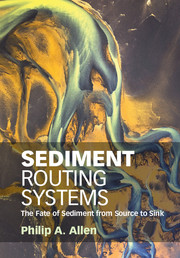Book contents
- Frontmatter
- Contents
- Preface
- Part I A Global View of Sediment Routing Systems
- Part II The Segments of Sediment Routing Systems
- Part III The Functioning of Sediment Routing Systems
- Part IV The Stratigraphic Record of Sediment Routing Systems
- 9 Sediment Production, Evolution and Provenance
- 10 Sediment Routing Systems and Sequence Stratigraphy
- References
- Index
10 - Sediment Routing Systems and Sequence Stratigraphy
from Part IV - The Stratigraphic Record of Sediment Routing Systems
Published online by Cambridge University Press: 03 October 2017
- Frontmatter
- Contents
- Preface
- Part I A Global View of Sediment Routing Systems
- Part II The Segments of Sediment Routing Systems
- Part III The Functioning of Sediment Routing Systems
- Part IV The Stratigraphic Record of Sediment Routing Systems
- 9 Sediment Production, Evolution and Provenance
- 10 Sediment Routing Systems and Sequence Stratigraphy
- References
- Index
Summary
In 2008, Philip Allen wrote (2008b) (p.23):
The more we make steps in understanding landscapes and sediment routing systems, the more we discern their complex response to perturbations of all types. Had such information been available previously to guide stratigraphic models, it is arguable that the entire field of sequence stratigraphy … would have developed differently.
This is not to say that sequence stratigraphy and sediment routing system research are at war with each other, or that they occupy two distinct philosophical schools and ‘social worlds’ (Clarke, 1991). The two approaches to the understanding of stratigraphy are complementary and should ideally be used in tandem (Helland-Hansen et al., 2016). Nevertheless, the difference in approach of numerical modelling, which investigates through simulations the effect on stratigraphic architectures of variations in controlling parameters, and currently practised sequence stratigraphy, which, it is claimed, makes observations on stratigraphic architectures irespective of the controls, has been recently highlighted (Cantuneanu and Zecchin, 2016). With this purist methodology, sequence stratigraphy is rather like making a geological map in the field: boundaries are defined and mapped irrespective of their interpretation. Hence, Cantuneanu and Zecchin (2016) state (p.185) that
numerical modeling … has no bearing on the sequence stratigraphic workflow or methodology.
But what makes stratigraphy interesting and valuable is its use to unravel and understand the ‘epic poem of the Earth’ (see Preface) in an explanatory sense. Integrated system-type approaches to the fate of sediment from source to sink, including numerical modelling, have the power to fundamentally inform the sequence stratigraphy narrative, particularly in terms of the forcing mechanisms for observed architectural patterns and trends.
Insights from Quaternary Studies
Although the sequence stratigraphy paradigm was built principally on the interpretation of Mesozoic-Tertiary sedimentary rocks deposited at passive margins, the principles of sequence stratigraphy, and the dominant role of relative sea level in fashioning sequence architectures, are better displayed by the Quaternary record of continental margins (Lobo and Ridente, 2014; Ridente, 2016). High-frequency cycles are best preserved where high sediment supply rates combine with tectonic subsidence beneath continental shelves, and where the shallow depths of burial allow high-quality seismic reflection imagery.
- Type
- Chapter
- Information
- Sediment Routing SystemsThe Fate of Sediment from Source to Sink, pp. 335 - 363Publisher: Cambridge University PressPrint publication year: 2017



